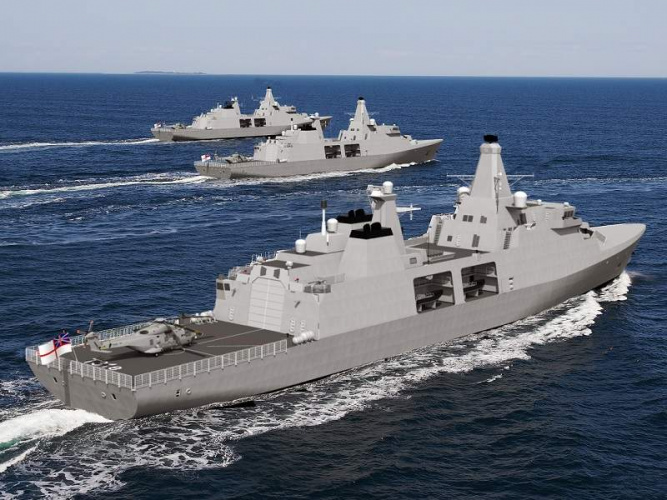
The next generation of Royal Navy warships will be built by Babcock, with the Ministry of Defence awarding preferred bidder status to a consortium led by the company and also including Thales. The Type 31 frigate will be built to a design known as Arrowhead 140, with each ship costing some £250m – a quarter of the cost per ship of the larger Type 26 frigates currently being built by BAE Systems in Glasgow.
Arrowhead 140 is derived from a design originally developed for the Danish Navy, and is described by Babcock as “a capable, adaptable and technology enabled global frigate”. Designed to be suitable for exports, the ships will be built using the modular construction method pioneered during the building of the Queen Elizabeth class aircraft carriers (in which Babcock was a consortium partner) with Rosyth serving as the central integration site. Detailed design work is scheduled to begin as soon as formal contracts have been signed, with construction starting in 2021 and the first ship in class to be launched in 2023. Babcock expects the program to run until 2027.
The contract is expected to secure some 1250 direct jobs at multiple locations around the UK at the height of the project, as well as a similar number in the supply chain. Babcock expects to develop around 150 new technical apprenticeships to serve the project.
The Babcock/Thales consortium beat rival bids from BAE Systems and Cammell Laird and a consortium led by Atlas Electronik UK. The winning consortium also includes Odense Maritime Technology (OMT), the Danish firm which originally designed the hull form of the Iver Huitfeldt-class frigates on which Arrowhead 140 is based; Harland and Wolff of Belfast, Ferguson Marine of Port Glasgow and BMT Defence Services, a centre of excellence for naval design and through-life support.
The completed ships will have a maximum overall length of 138.7m, maximum beam of 19.8m, and design draft of 4.8m. The crew complement will be 100 to 160 sailors, and each ship will be able to accommodate an AW–10 Merlin or MH-60 Seahawk helicopter in an on-board hanger which will also be able to house light aircraft and UAVs. Boat bays on either side of the frigate will be able to deploy rigid hulled inflatable boats and autonomous underwater or surface vessels. Reconfigurable spaces on board will be able to store containers for humanitarian aid and disaster relief operations, and can also be used as accommodation for people associated with such operations. Armaments on board will include 40mm to 127mm deck mounted guns, canister-launched surface-to-surface guided weapons, vertical launch missiles, and surface-to-air, land strike and anti-submarine missiles.
The vessel will be powered by a combined diesel and diesel (CODAD) propulsion system incorporating four diesel engines, two propellers and two variable shaft lines, producing a maximum power of 32.8MW. This will give it a cruising speed of 18kt and a maximum speed of 28kt.
Babcock chief executive Archie Bethel said: “It has been a tough competition and we are absolutely delighted that Arrowhead 140 has been recognised as offering the best design, build and delivery solution for the UK’s Royal Navy Type 31 frigates.
“Driven by innovation and backed by experience and heritage, Arrowhead 140 is a modern warship that will meet the maritime threats of today and tomorrow, with British ingenuity and engineering at its core. It provides a flexible, adaptable platform that delivers value for money and supports the UK’s National Shipbuilding Strategy.”
For Thales, UK chief executive Victor Chavez added “With the announcement today that Arrowhead 140 has been selected as the preferred bidder for the new Type 31e frigate, the Royal Navy will join the global community of 26 navies utilising the Thales Tacticos combat management system. Thales already provides the eyes and ears of the Royal Navy and will now provide the digital heart of the UK’s next generation frigates.”
Paul Everitt, chief executive of defence industry organisation ADS, commented that the announcement was welcome news for the UK defence and shipbuilding industry. “This contract will protect and create high-value UK jobs, contribute to national prosperity, protect our national security and provide potential for export orders with our international allies and partners. The long-term programme of naval shipbuilding at UK shipyards, including both the Type 31 and Type 26, provides a solid foundation for the defence maritime sector to grow its exports, securing the future of this technologically advanced and innovative industry in the UK for the years ahead.”




Glasgow trial explores AR cues for autonomous road safety
They've ploughed into a few vulnerable road users in the past. Making that less likely will make it spectacularly easy to stop the traffic for...